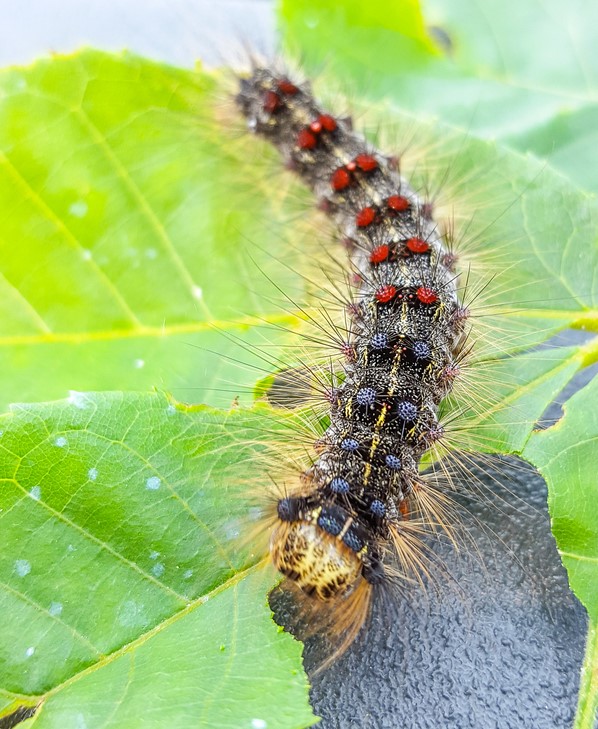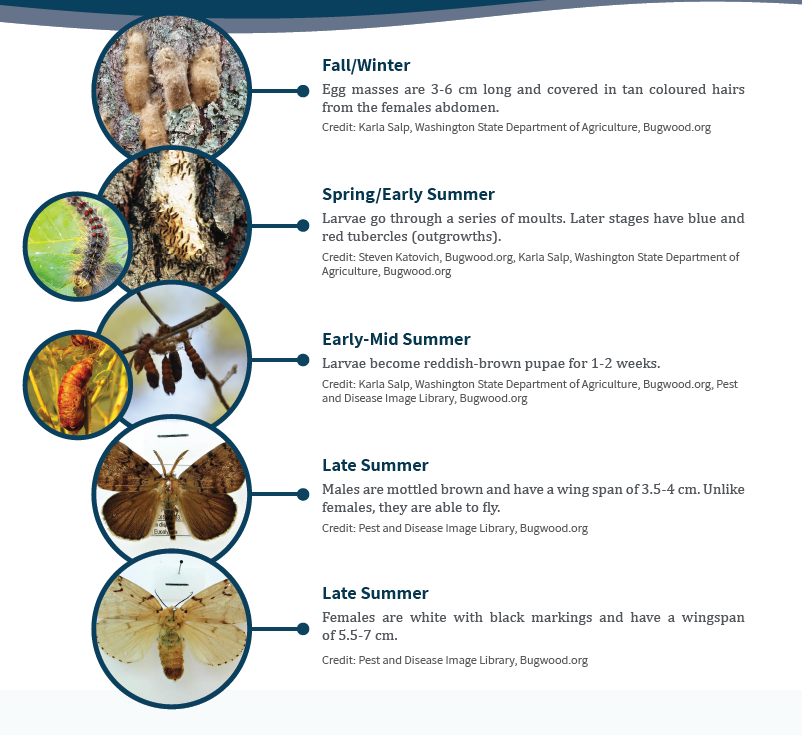| Scientific name: | Lymantria dispar dispar |
| French name: | La spongieuse nord-américain |
| Common name(s)*: | Spongy moth, LDD moth
*This insect was formerly known as the ‘European Gypsy Moth’, however this name is no longer used because it is derogatory. Spongy moth is the new common name for the species. |
| Regulatory status: | Spongy moths are on the List of Pests Regulated by Canada (under the Plant Protection Act), with ten policy directives associated with its listing. |

Description:
Spongy moths are insects native to Europe. They feed on the leaves of a wide range of host trees, including oak, willow, birch, and maple (Jahant-Miller 2020, Keena and Richards 2020, Haq et al. 2021)
Introduction and spread:
Spongy moths were introduced to North America 1869 as part of a failed silk-worm breeding experiment (Gooderham et al. 2021).
Spongy moth larvae can naturally disperse short distances on windblown silk threads (Jahant-Miller 2020, Gooderham et al. 2021). Adult males can fly short distances, however adult females cannot. Spongy moths can spread further distances by being accidentally transported by humans. Any life stages may be spread by humans, however it is particularly easy to accidentally transport the eggs, which can be laid on many different surfaces (e.g., wood, plants, stone, inorganic materials).
Potential industrial vectors (i.e., means of movement) for spongy moths include shipping pallets, containers, cargo, trains, commercial trucks, and imports of stone and wood.
Potential domestic vectors for spongy moths include firewood, vehicles (cars, trailers, ATVs), hiking or outdoor gear, and pets.
Distribution:
Since their initial establishment in Boston, USA, they have spread into and established in other northeastern states and eastern Canada. There are established populations in Quebec, New Brunswick, Nova Scotia, Ontario, and Prince Edward Island (CFIA 2022). Spongy moths have also been detected in British Columbia, Alberta, Saskatchewan, and Manitoba, however these introductions have been eradicated.
Impacts:
- Feeding spongy moths defoliate (i.e., remove the leaves from) their host trees (Gooderham et al. 2021). Severe defoliation makes trees susceptible to attack from other insects and diseases (CFIA 2021). Repeated defoliation may kill a tree.
- In 2021, spongy moths defoliated 1.8 million hectares of trees in Ontario – that’s equivalent to more than 3 million football fields!
- Damage from spongy moths lowers the economic value of trees (Jahant-Miller 2020).
- Physical contact with spongy moths may cause minor health concerns, including dermatitis, eye irritation, and respiratory complaints (Gooderham et al. 2021, Haq et al. 2021)
- Spongy moth control is costly (Jahant-Miller 2020, CFIA 2021).
- Spongy moth control has negative impacts on other species, including native butterflies and moths (CFIA 2021).
Life Cycle:
Management Actions:
Everyone can help prevent the spread of spongy moths by doing the following:
- Check before you go:
- Check your vehicle. Spongy moths can spread by hitchhiking or laying eggs on cars, trailers, campers, or ATVs. Carefully inspect your vehicle for spongy moth eggs, caterpillars, or moths. Sweep out your trailer and camper. Remove any plants, insects, or mud.
- Check your outdoor items and gear. Spongy moths are found in rural and urban areas. So, it’s important to inspect all your outdoor items, including grills, patio furniture, yard games, and camping gear.
- Don’t move firewood. Spongy moths feed or lay eggs on more than 300 plant and tree species. Buy firewood close to where you will use it, so you avoid transporting unwanted hitchhikers. Leave unused firewood on site.
- Destroy it! Scrape off and destroy egg masses or caterpillars by placing them in hot, soapy water and leaving them to soak for at least 2 days before disposing of them in the garbage.
- Observe and Report.
- Keep an eye out for spongy moths, especially in western Canada or Newfoundland. Visit reportcanadainvasives.ca to learn how to report invasive species in your province or territory.
Additional resources:
References
CFIA (Canadian Food Inspection Agency). 2022. Lymantria dispar dispar (LDD) moth. Web page available at: https://inspection.canada.ca/plant-health/invasive-species/insects/ldd-moth-and-agm/ldd-moth/eng/1329836269430/1329836504450
CFIA (Canadian Food Inspection Agency). 2021. Lymantria dispar dispar (LDD moth) – Fact sheet. 2021. Web page available at: https://inspection.canada.ca/plant-health/invasive-species/insects/ldd-moth-and-agm/fact-sheet/eng/1330355335187/1335975909100
Gooderham, M., Haq, M., Beecker, J., & O’Toole, A. (2021). Lymantria dispar dispar (Gypsy) Moth Dermatitis. Journal of Cutaneous Medicine and Surgery, 25(5), 555–556. https://doi.org/10.1177/12034754211032206
Haq, M., O’Toole, A., Beecker, J., & Gooderham, M. J. (2021). Return of Lymantria dispar dispar (gypsy moth): A case report. SAGE Open Medical Case Reports, 9, 2050313X2110579. https://doi.org/10.1177/2050313×211057926
Jahant-Miller, C.J. 2020. Environmental drivers of morphological and physiological adaptation in an invasive defoliator, Lymantria dispar. Doctoral thesis, State University of New York.
Keena, M. A., & Richards, J. Y. (2020). Comparison of survival and development of gypsy moth Lymantria dispar L. (Lepidoptera: Erebidae) populations from different geographic areas on North American conifers. Insects, 11(4), 260. https://doi.org/10.3390/insects11040260


